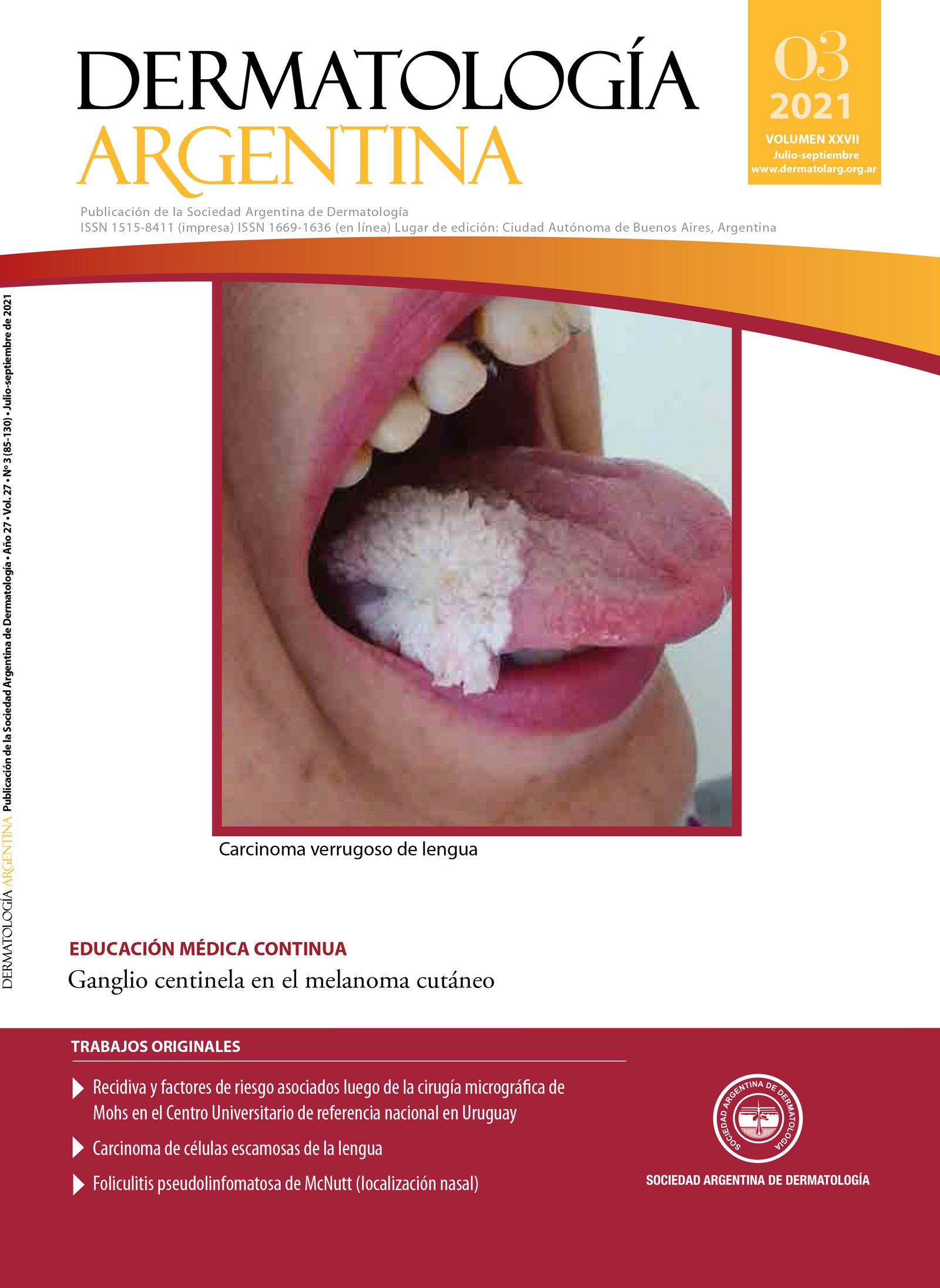Ganglio centinela en el melanoma cutáneo
DOI:
https://doi.org/10.47196/da.v27i3.2179Palabras clave:
ganglio centinela, biopsia, melanoma cutáneoResumen
La biopsia selectiva del ganglio centinela (BSGC) se ha desarrollado de tal manera que reemplazó a la linfadenectomía electiva en el tratamiento del melanoma cutáneo (MC). Numerosos estudios demostraron que el estado del ganglio centinela es un factor pronóstico independiente en relación con la supervivencia global y la supervivencia libre de enfermedad de los pacientes con melanoma. El objetivo del presente trabajo fue realizar una revisión bibliográfica para compender la utilidad y las indicaciones de la BSGC en pacientes con MC a partir de la evidencia actual publicada.
Citas
I. Loria D, Abriata MG, Santoro F, Latorre C. Cutaneous melanoma in Argentina: an analysis of its characteristics and regional di erences. Ecancermedicalscience. 2020;14:1017.
II. Howlader N, Noone AM, Krapcho M, Miller D, et ál. SEER Cancer Statistics Review, 1975.2017, National Cancer Institute [en línea]. SEER data submission, posted to the SEER web site. 2020. Disponible en: <https://seer.cancer.gov/csr/1975_2017> [Consultado septiembre 2020].
III. Latorre C, Stengel F, Loria D. Melanoma cutáneo : mortalidad y características de los tumores incidentes en los dos extremos de la vida en la Argentina. Dermatol Argent. 2012;18:30-35.
IV. Loria D, González A, Latorre C. Epidemiología del melanoma cutáneo en Argentina: análisis del Registro Argentino de Melanoma Cutáneo. Dermatol Argent. 2010;16:39-45.
V. Swetter SM, Thompson JA, Albertini MR, Barker CA, et ál. Cutaneous Melanoma. Versión 4. 2020. [en línea], National Comprehensive Cancer Network clinical practice guidelines in oncology. Disponible en: <https://www.nccn.org/ professionals/physician_gls/pdf/cutaneous_melanoma.pdf/> [Consultado septiembre 2020].
VI. Chakera AH, Hesse B, Burak Z, Ballinger JR, et ál. EANM.EORTC general recommendations for sentinel node diagnostics in melanoma. Eur J Nucl Med Mol Imaging. 2009;36:1713-1742.
VII. Gershenwald JE, Scolyer RA, Hess KR, Sondak VK, et ál. Melanoma staging: Evidence based changes in the American Joint Committee on Cancer eighth edition cancer staging manual. CA Cancer J Clin. 2017;67:472-492.
VIII. Wong SL, Faries MB, Kennedy EB, Agarwala SS, et ál. Sentinel Lymph Node Biopsy and management of regional lymph nodes in melanoma: American Society of Clinical Oncology and Society of Surgical Oncology Clinical Practice Guideline Update. Ann Surg Oncol. 2018;36:399-413.
IX. Morton DL, Wen Dr, Wong JH, Economou JS, et ál. Technical details of intraoperative lymphatic mapping for early stage melanoma. Arch Surg. 1992;127:392-399.
X. Cascinelli N, Morabito A, Santinami M, MacKie R, et ál. Immediate or delayed dissection of regional nodes in patients with melanoma of the trunk: a randomised trial. Lancet. 1998;351:793-796.
XI. Morton DL, Thompson JF, Cochran AJ, Mozillo N, et ál. Final Trial Report of Sentinel-Node Biopsy versus Nodal Observation in Melanoma. N Engl J Med. 2014;370:599-609.
XII. Leiter U, Stadler R, Mauch C, Hohenberger W, et ál. Final Analysis of DeCOG-SLT Trial: No Survival Bene t for Complete Lymph Node Dissection in Patients With Melanoma With Positive Sentinel Node. J Clin Oncol. 2019;37:3000-3008.
XIII. Faries MB, Thompson JF, Cochran AJ, Andtbacka RH, et ál. Completion dissection or observation for sentinelnode metastasis in melanoma. N Engl J Med. 2017;376:2211-2222.
XIV. González A. Sentinel lymph node biopsy: Past and present implications for the management of cutaneous melanoma whit nodal metastasis. Am J Clin Dermatol. 2018;19:24S-30S.
XV. Snow H. Abstract of a lecture on melanotic cancerous disease. Lancet. 1892;15:872-874.
XVI. Sim FH, Taylor WF, Pritchard DJ, Soule EH. Lymphadenectomy in the management of stage I malignant melanoma: a prospective randomized study. Mayo Clin Proc. 1986;61:697-705.
XVII. Veronesi U, Adamus J, Bandiera DC, Brennhovd OI, et ál. Delayed regional lymph node dissection in stage I melanoma of the skin of the lower extremities. Cancer. 1982;49:2420-2430.
XVIII. Balch CM, Soong SJ, Bartolucci AA, Urist MM, et ál. E cacy of an elective regional lymph node dissection of 1 to 4 mm thick melanomas for patients 60 years of age and younger. Ann Surg. 1996;224:255-266.
XIX. Braithwaite LR. The ow of lymph from the ileocæcal angle, and its possible bearing on the cause of duodenal and gastric ulcer. Br J Surg. 1923;11:7-26.
XX. Virchow R CF. Lecture VIII- Blood and Lymph. En: Virchow R, Chance F. Celular Pathology. Londres; 1860:156-176.
XXI. Sherman AI, Ter-Pogossian M. Lymph node concentratation of radioactive colloidel gold following interstitial injection. Cancer. 1953;6:1238-1240.
XXII. Gould EA, Winship T, Philbin PH Kerr HH. Observations on a “sentinel node” in cancer of the parotid. Cancer. 1960;13:77-78.
XXIII. Sayegh E, Brooks T, Sacher E, Busch F. Lymphangiography of the retroperitoneal lymph nodes through the inguinal route. J Urol. 1966;95:102-107.
XXIV. Cabanas RM. An approach for the treatment of penile carcinoma. Cancer. 1977;39:456-466.
XXV. Fernández A, Vidal-Sicart S. El ganglio centinela. Concepto y aplicaciones clínicas en neoplasias de mama y melanoma. Rev Esp Med Nuclear. 2000;19:371-390.
XXVI. Ross GL, Soutar DS, Gordon MacDonald D, Shoaib T, et ál. Sentinel node biopsy in head and neck cancer: preliminary results of a multicenter trial. Ann Surg Oncol. 2004;11:690-696.
XXVII. Tsujino Y, Mizumoto K, Matsuzaka Y, Niihara H, et ál. Fluorescence navigation with indocyanine green for detecting sentinel nodes in extramammary Paget’s disease and squamous cell carcinoma. J Dermatol. 2009;36:90-94.
XXVIII. Morton DL, Chan AD. The concept of sentinel node localization: How it started. Semin Nucl Med. 2000;30:4-10.
XXIX. Tanis PJ, Nieweg OE, Valdés Olmos RA, Th Rutgers EJ, et ál. History of sentinel node and validation of the technique. Breast Cancer Res. 2001;3:109-112.
XXX. Tejera-Vaquerizo A, Barrera-Vigo MV, Fernández-Canedo I, Blázquez-Sánchez, et ál. Estudio temporal de los diferentes patrones metastásicos en la progresión del melanoma cutáneo. Actas Dermosi liogr. 2007;98:531-538.
XXXI. Meier F, Will S, Ellwanger U, Schlagenhau B, et ál. Metastatic pathways and time courses in the orderly progression of cutaneous melanoma. Br J Dermatol. 2002;147:62-70.
XXXII. Fidler IJ. The pathogenesis of cancer metastasis: the “seed and soil” hypothesis revisited. Nat Rev Cancer. 2003;3:453-458.
XXXIII. Gassenmaier M, Eigentler TK, Keim U, Goebeler M, et ál. Serial
or parallel metastasis of cutaneous melanoma? A study of the german central malignant melanoma registry. J Invest Dermatol. 2017;137:2570-2577.
XXXIV. Medalie N, Ackerman AB. Sentinel node biopsy has no bene t for patients whose primary cutaneous melanoma has metastasized to a lymph node and therefore should be abandoned now. Br J Dermatol. 2004;151:298-307.
XXXV. Halsted WS. The results of radical operations for the cure of carcinoma of the breast. Ann Surg. 1907;46:1-19.
XXXVI. Leong SPL. Paradigm of metastasis for melanoma and breast cancer based on the sentinel lymph node experience. Ann Surg Oncol. 2004;11:192S-197S.
XXXVII. Morton DL, Cochran AJ. The case for lymphatic mapping and sentinel lymphadenectomy in the management of primary melanoma. Br J Dermatol. 2004;151:308-319.
XXXVIII. Pharis DB, Zitelli JA. The management of regional lymph nodes in cancer. Br J Dermatol. 2003;149:919-925.
XXXIX. Pizarro A, Redondo P. Melanoma dissemination and the usefulness of sentinel lymph node biopsy: a reappraisal. Skin Cancer. 2004;19:221-230.
XL. Bagaria SP, Faries MB, Morton DL. Sentinel node biopsy in melanoma: Technical considerations of the procedure as performed at the John Wayne Cancer Institute. J Surg Oncol. 2010;101:669-676.
XLI. Cochran AJ, Balda BR, Starz H, Bachter D, et ál. The Augsburg Consensus. Techniques of lymphatic mapping, sentinel lymphadenectomy, and completion lymphadenectomy in cutaneous malignancies. Cancer. 2000;89:236-241.
XLII. Berman CG, Choi J, Hersh MR, Clark RA. Melanoma lymphoscintigraphy and lymphatic mapping. Semin Nucl Med. 2000;30:49–55.
XLIII. Tsao H, Atkins MB, Sober AJ. Management of cutaneous melanoma. N Engl J Med. 2004;351:998-1012.
XLIV. Even-Sapir E, Lerman H, Lievshitz G, Kha f A, et ál. Lymphoscintigraphy for sentinel node mapping using a hybrid SPECT/CT system. J Nucl Med. 2003;44:1413-1420.
XLV. Leong SPL. Selective sentinel lymphadenectomy for malignant melanoma. Surg Clin North Am. 2003;83:157-185.
XLVI. Albertini JJ, Cruse CW, Rapaport D, Wells K, et ál. Intraoperative radiolymphoscintigraphy improves sentinel lymph node identi cation for patients with melanoma. Ann Surg. 1996;223:217-224.
XLVII. Vidal-Sicart S, Vilalta Solsona A, Alonso Vargas MI. Ganglio centinela en melanoma y cáncer de mama. Consideraciones actuales. Rev Esp Med Nucl Imagen Mol. 2015;34:30-44.
XLVIII. Bluemel C, Herrmann K, Giammarile F, Nieweg OE, et ál. EANM practice guidelines for lymphoscintigraphy and sentinel lymph node biopsy in melanoma. Eur J Nucl Med Mol Imaging. 2015;42:1750-1766.
XLVIX. Schneebaum S, Even-Sapir E, Cohen M, Shacham-Lehrman H, et ál. Clinical applications of gamma-detection probes radioguided surgery. Eur J Nucl Med. 1999;26:26S–35S.
L. Wilhelm AJ, Mijnhout GS, Franssen EJF. Radiopharmaceuticals in sentinel lymph-node detection–an overview. Eur J Nucl Med. 1999;26:36S-42S.
LI. Cook MG, Green MA, Anderson B, Eggermont AMM, et ál. The development of optimal pathological assessment of sentinel lymph nodes for melanoma. J Pathol. 2003;200:314-319.
LII. Gershenwald JE, Colome MI, Lee JE, Mans eld PF, et ál. Patterns of recurrence following a negative sentinel lymph node biopsy in 243 patients with stage I or II melanoma. J Clin Oncol. 1998;16:2253-2260.
LIII. Morton DL, Thompson JF, Cochran AJ, Mozzillo N, et ál. Sentinel-node biopsy or nodal observation in melanoma. N Engl J Med. 2006;355:1307-1317.
LIV. Veenstra HJ, Wouters MJWM, Kroon BBR, Olmos RAV, et ál. Less false-negative sentinel node procedures in melanoma patients with experience and proper collaboration. J Surg Oncol. 2011;104:454-457.
LV. Caracó C, Marone U, Celentano E, Botti G, et ál. Impact of false- negative sentinel lymph node biopsy on survival in patients with cutaneous melanoma. Ann Surg Oncol. 2007;14:2662-2667.
LVI. Durham AB, Wong SL. Sentinel lymph node biopsy in melanoma: controversies and current guidelines. Future Oncol. 2014;10:429-442.
LVII. Kachare SD, Singla P, Vohra NA, Zervos EE, et ál. Sentinel lymph node biopsy is prognostic but not therapeutic for thick melanoma. Surgery. 2015;158:662-668.
LVIII. Van Akkooi ACJ, Voit CA, Verhoef C, Eggermont AMM. New developments in sentinel node staging in melanoma: controversies and alternatives. Curr Opin Oncol. 2010;22:169-177.
LIX. Teixeira V, Vieira R, Coutinho I, Cabral R, et ál. Prediction of Sentinel node status and clinical outcome in a melanoma centre. J Skin Cancer. 2013;2013:1-7.
LX. Cadili A, Dabbs K. Predictors of sentinel lymph node metastasis in melanoma. Can J Surg. 2010;53:32-36.
LXI. Breslow A. Tumor Thickness, Level of invasion and node dissection in stage I cutaneous melanoma. Ann Surg. 1975;182:572-575.
LXII. Van Akkooi ACJ. Sentinel node followed by completion lymph node dissection versus nodal observation: staging or therapeutic? Controversy continues despite nal results of MSLT-1. Melanoma Res. 2014;24:291-294.
LXIII. Coit D. Sentinel lymph node biopsy for melanoma: A plea to let the data speak. Ann Surg Oncol. 2014;21:3359-3361.
LXIV. Sladden M, Zagarella S, Popescu C, Bigby M. No survival bene t for patients with melanoma undergoing sentinel lymph node biopsy: critical appraisal of the Multicenter Selective Lymphadenectomy Trial-I nal report. Br J Dermatol. 2015;172:566-571.
LXV. McGregor JM, Sasieni P. Sentinel node biopsy in cutaneous melanoma: time for consensus to better inform patient choice. Br J Dermatol. 2015;172:552-554.
LXVI. Berk DR, Johnson DL, Uzieblo A, Kiernan M, et ál. Sentinel lymph node biopsy for cutaneous melanoma. Arch Dermatol. 2005;141:1016-1022.
LXVII. Van der Ploeg APT, Haydu LE, Spillane AJ, Quinn MJ, et ál. Outcome following sentinel node biopsy plus wide local excision versus wide local excision only for primary cutaneous melanoma. Ann Surg. 2014;260:149-157.
LXVIII. Bamboat ZM, Konstantinidis IT, Kuk D, Ariyan CE, et ál. Observation after a positive sentinel lymph node biopsy in patients with melanoma. Ann Surg Oncol. 2014;21:3117-3123.
LXIX. Kingham TP, Panageas KS, Ariyan CE, Busam KJ, et ál. Outcome of patients with a positive sentinel lymph node who do not undergo completion lymphadenectomy. Ann Surg Oncol. 2010;17:514-520.
LXX. Lee DY, Lau BJ, Huynh KT, Flaherty DC, et ál. Impact of completion lymph node dissection on patients with positive sentinel lymph node biopsy in melanoma. J Am Coll Surg. 2016;223:9-18.
LXXI. Coit D. The enigma of regional lymph nodes in melanoma. N Engl J Med. 2017;376:2280-2281.
LXXII. Van Akkooi ACJ, Hayes A. Recent developments in lymph node surgery for melanoma. Br J Dermatol. 2019;180:5-7.
LXXIII. Bigby M, Zagarella S, Sladden M, Popescu CM. Time to
reconsider the role of sentinel lymph node biopsy in
melanoma. J Am Acad Dermatol. 2019;80:1168-1171.
LXXIV. Zagarella S, Lee S, Heenan P. Sentinel lymph node biopsy status is not the most powerful predictor of prognosis in cutaneous melanoma. Australas J Dermatol. 2017;58:256-258.
Descargas
Publicado
Número
Sección
Licencia
Derechos de autor 2021 Sociedad Argentina de Dermatología

Esta obra está bajo una licencia internacional Creative Commons Atribución-NoComercial-SinDerivadas 4.0.
El/los autor/es tranfieren todos los derechos de autor del manuscrito arriba mencionado a Dermatología Argentina en el caso de que el trabajo sea publicado. El/los autor/es declaran que el artículo es original, que no infringe ningún derecho de propiedad intelectual u otros derechos de terceros, que no se encuentra bajo consideración de otra revista y que no ha sido previamente publicado.
Le solicitamos haga click aquí para imprimir, firmar y enviar por correo postal la transferencia de los derechos de autor













